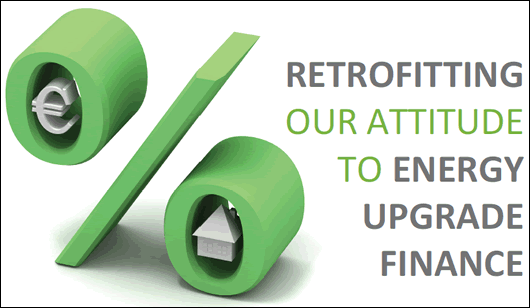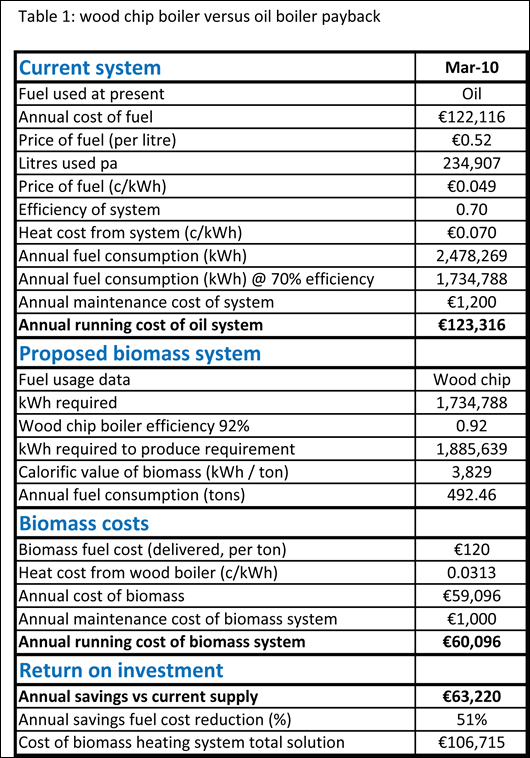- Retrofit
- Posted
Retrofitting investment

The government is aiming to energy upgrade one million buildings by 2020, but huge investment will be needed to reach that goal. According to finance expert Jack O’Keeffe of Larchmont Consulting, it will only be achieved through a combination of new financing mechanisms, credible payback periods, and smarter loan evaluation.
There is no shortage of ideas, products or solutions for reducing CO2 emissions in line with current targets. The rationale and commercial benefits associated with CO2 reductions are compelling and have permeated through to the industrial and commercial sectors, and to the ordinary consumer.
However acceptance of change and awareness of the benefits this drive will bring are not to the forefront for ordinary consumers. Some very obvious reasons exist for this — such as the need to focus on surviving the current economic crisis, scepticism about the cost-benefit of a deep retrofit (and even understanding what a deep retrofit is) and a lack of the funds needed to carry out energy upgrades. This article will focus on the issue of funding.
In non-residential sectors (industrial, commercial, public), the level of capital needed to kick start a long term energy retrofit programme will be enormous, and getting it will be challenging. It is therefore vital to identify the factors that will influence the flow of money into this sector. This is particularly relevant in the current climate where banks, and especially Irish banks, are short of capital and unable to commit any large lending resources to this sector.
This should improve over time, but even then the programme for retrofitting will need to address:
a) Pay back periods
b) Affordability
c) Industry credibility/integrity
d) Risk versus reward
e) Enhanced value
f) Other industry participants
In looking at the funding criteria which would underpin any investor's decision, it is important to consider the scale of capital needed to fund a long term retrofit programme. Various calculations have been done by industry groups, but let’s just take one example: say over the next three years that 100,000 houses are retrofitted at an average cost of €20,000. This would cost €2 billion. Getting the enormous investment needed will require a long term approach with some innovative financing schemes. It will not be achieved with current funding methods and methods of financial appraisal.
Payback period
One of the key factors is the payback period. This is crucial for both residential and commercial building owners, as to shift from one source of energy to another inevitably requires capital outlay. The contractor/supplier of the system has to be paid, and generally up-front.
Any investment appraisal will require an analysis by the customer to ensure the money they are spending is justified and will result in savings (lower utility costs) and gains (enhanced value of property) over time, as well as enhanced usability and building efficiency. The shorter the payback period, the more confident the customer will be and the more likely they will sign up. Consumers will then start to see energy retrofit as a good investment, rather than just a big cost item.
The payback period is also a critical factor for lenders, and one that is currently not considered when looking at ability to repay in the residential or commercial sectors. But if banks take cognisance of this, lending decisions to support spending and investment can be taken with more confidence. This is especially relevant when assessing investment decisions in the commercial, SME and public sectors. In the residential sector, banks have well-established evaluation criteria to assess ability to repay, with significant levels of supporting credit information and refined scoring systems. This is not to say that the current system would not benefit from modification — it would, as improving the payback period would enhance and improve any lending/investment proposition. When one looks particularly at the scale of the non-residential building stock and the cost of retrofitting it, the numbers are extremely challenging. It is therefore critical that payback periods are factored into the investment and lending decision process.
Affordability
So how is the issue of payback period addressed?
Table 1 shows a calculation of the savings of a new heating system versus the existing annual operating costs. It also shows the capital costs associated with installing the new system and a resulting payback period of less than two years.

Now for any financial controller or business owner, even before considering the green agenda, this makes sense. The big hurdle is how to finance this investment.
If these assumptions and the financial analysis are correct, it should be possible to get funding for this investment — and not necessarily from the traditional source, a bank. However, this brings me on to my next critical factor, the integrity of the industry itself.
Industry credibility & integrity
The payback argument above appears compelling on the surface. For this to gain traction the retrofit industry needs to ensure that the underlying assumptions are valid and that the payback period forecast (as the basis for the investment) is achieved.
With shorter payback periods the credibility of the assumptions will be quickly proven. This is where the industry can play a critical role, first by ensuring that the assumptions have integrity and are proven, and then in promoting and educating other key constituents — such as investors — about the commercial opportunities in the sector.
Currently banks do not take into account energy cost savings when calculating ability to repay loans for retrofit. If the payback period can be proven, banks will approach this with more confidence.
The retrofit industry can play an important role in establishing the links (probably a linear one) between the level of investment and the level of savings (positive cash flow) from lower utility bills, helping to establish the key principle that money spent on retrofitting or replacing existing energy systems will result in significant savings and enhance repayment capacity.
Then consumers, building owners and occupants will become convinced that their capital outlay is not a cost but an investment — one that has a natural payback, commercial integrity and adds value to their property.
One way to achieve this is to have a rigorous review mechanism for evaluating projected versus actual savings in utility bills. This is difficult and complex as it could be influenced by both user habits (no capital cost) and improved insulation (capital cost). Nevertheless, the industry and the National Energy Retrofit Programme would benefit greatly in the long term by having some standards around this.
Energy efficient mortgages
Energy Efficient Mortgages (EEMs) have been around in the US for some time. They recognise that investment in energy improvements results in lower utility costs, and as a result EEMs can allow for up to 15% extra loan funding. This important precedent recognises the link between improved energy efficiency from an appropriate retrofit and the lower energy costs that result. Projected savings are taken into account by the lender in calculating the homeowner's ability to repay.
Further research has been done to examine why there has been such a low take up of EEMs, and a bill to address deficiencies was introduced in 20081. The popularity of EEMs is likely to grow as general awareness of energy issues improves and utility costs spiral, and as the link between retrofitting and lower energy bills becomes clear.
Risk and reward
Many papers have been written about the substantial requirement for funding for the green sector, highlighting relevant factors such as the importance of the sector both globally and nationally, its scale, its huge potential, and the importance of participating in it. Most people and institutions can empathise with these to one degree or another.
Notwithstanding the above, the level of participation by investors and lenders has not matched the demand for funding to date. This is typical in the cycle of any growth industry, particularly when a capital intensive sector balloons in the early stage of development.
This is further exacerbated by the current state of the global banking market as it attempts to rebuild confidence and balance sheet capacity (by increasing capital and reducing lending). Investors have been burned by even conservative investment strategies, and are gun shy about re-entering the investment markets.
There has been significant growth in the number of funds specifically aimed at the green sector. These tend to invest in established quoted entities or fund completed projects, or in government-supported infrastructural projects. In terms of funding for the National Energy Retrofit Programme or infrastructural projects, this is going to have to be led mainly by the host nation, as every similar economy is striving to implement similar programmes and objectives.
In June, the UK's Green Investment Commission recommended that a green investment bank be established “to support the delivery of the UK’s emission reduction targets as set by the Climate Change Act 2008. The support should be based on a public-private investment model and address specific market failures and investment barriers, in a way that will achieve emission reductions at least cost to taxpayers and energy consumers.”2
The challenge of funding a large retrofit programme in Ireland is exacerbated by the existence of generous tariff regimes in other jurisdictions. These are a further drain, as educated investors who have made the decision to commit funds to the green sector are looking at opportunities outside Ireland.
This is then further compounded in the case of institutional pension funds that are strategically committed to increasing their allocation to non-Irish assets.3 There are a number of examples of individual pension fund investors and some corporate pension funds investing in overseas renewable energy projects. The main reasons are the attractiveness of the projected returns, the quality of the projects and their suitability as an investment (long term annuity characteristic) for pension investments.
Public private partnerships are another relevant mechanism that could be suitable as a funding mechanism.
Suitability for pension investments
Long term benefits — Long term return — Long term funding
When looking at the features of both infrastructural projects and retrofit programmes (particularly deep retrofits), it is clear the benefits accrue over a medium to long term time period.
In the context of my earlier point about the need to expand the range of funding providers, a key source for this is the pension fund industry — either as institutional/corporate providers or through the large number of self administered pension schemes which, although ‘battered’ in recent times, are looking for alternative and better investments to fund their retirement needs and profile. Given the long term profile above and the long term profile of the liability curve of the pension industry, this could be a suitable match for funders (pension industry) and borrowers for a national energy retrofit scheme.
Which brings me to the main point of this segment: risk and reward. Given the reluctance of lenders and investors, and the unproven non-established nature of the energy retrofit sector, it is critical that the risk-reward balance reflects this. This is not the only factor that will persuade reluctant, traditional investors to commit to this sector but, if sufficiently attractive, it will at least start to focus their attention and force more consideration of this sector.
It is not that people aren't looking at this sector — it's more a case of the uncertainty of the returns, the lack of empirical evidence and the natural reluctance for pension fund managers/ trustees to embrace another new 'trend'.
If the rewards are attractive enough then investors will look more aggressively at these investments, but the projects need to stack up in terms of credibility, returns, liquidity over time, transparency and scalability.
With attractive returns — especially when risk weighted — more investors will enter the market and begin to create some liquidity and scale. This and the usual skills of the investment community should lead to more innovative product packaging and unitisation, thereby allowing the smaller retail investor to participate. This will be important for the long term development of this sector as a suitable investment asset class. However, care needs to be taken from the outset to ensure the fundamentals are sound and actually achieved – in other words savings in costs of energy and taxes, project management and cost control, enhancement in long term asset value and improved efficiencies and quality.
The proposition from the industry that energy retrofit is an investment rather than a cost needs to stand up over time. If that is achieved — and it will be slowly but surely — then confidence will escalate from consumer to funder to allow the prudent but necessary finance to become available, and more importantly to allow retrofit programmes be self financing over the medium to long term.
Enhanced value
Another professional body who can play a part but who need to modify some of their evaluation criteria are the valuers. Suffice to say that if you were to make a significant investment in your property, such as a new kitchen or conservatory, you would expect to see an uplift in its value that closely matched that investment. Likewise — and with more justification if the projected energy savings are achieved — an investment in retrofit (particularly deep retrofit) should be reflected in increased property value if done properly. Then property owners will recognise the benefit of their investment, and interest in properly evaluating and making investments in energy retrofit will grow.
Other industry participants and the benefits they bring
Energy service companies
Energy Service Companies (Escos) generally underwrite or guarantee a level of savings from an agreed energy programme. They have been an important catalyst in recent years. The additional role they play as financiers, where they essentially undertake the role of lenders, has greatly expanded the development of this market in the commercial and public sectors.
They underpin the important criteria mentioned, in particular:
a) Industry credibility and integrity — they in essence verify the financial assumptions and underwrite them
b) Payback periods — they evaluate and agree the payback period
c) Risk versus reward — they establish the savings and agree a gain sharing arrangement
d) Affordability — again this is linked and underpinned by their assessments, and funding programmes are customised to suit each project.
However funding levels required to support these programmes are a limiting factor, and even the largest players will have difficulty in raising the funds to support the level of investment that will be required over the next few years. This is where a marriage of pension funds and infrastructural funds would be logical and mutually beneficial. The financial benefits and industry expertise could create an attractive investment opportunity and an additional source of long term funding.

|
| Bob Wigley , chairman of the UK’s Greennvestment Bank Commission which recomm- ende in June that a green investment bank be established |
Insurance Companies
Another peripheral party that could play a role in this initiative are insurance companies. Let's assume that a proper energy retrofit achieves significant cost savings — if an insurance company was to underwrite the cost savings or a portion of them, this would enhance a loan proposition to a bank. Obviously the insurance company would do its own due diligence and if the factors mentioned earlier — credibility, performance (largely dependent on reputable contractors) — stacked up, this would add to the overall attractiveness of the sector and allow greater underwriting in particular by banks, and increase confidence that projected savings would be achieved. This would be particularly beneficial when trying to fund a national retrofit programme for the commercial and public sectors.
Others
Engineers, architects and quantity surveyors all have a crucial part to play in inputting into this debate too, and in shaping a programme to achieve the type and scale of retrofit required. They can have a key influence on the economics of retrofit through design, management, policy and standards, and of course they impact on the integrity factor.
Further government incentives
The government could also give further stimulus through taxation measures. Capital allowances (accelerated) already exist when companies buy energy efficient products, but to meet the level of investment required some further personal and corporate tax incentives may be necessary.
This in principle runs counter to the government's objective of eliminating tax breaks that particularly benefit high earners. However, some level of tax incentive could be considered as its use would be more equitably spread across the broader residential sector, and through a cocktail of carbon tax, carbon credits and tax allowances, it could be structured to encourage investment while being revenue neutral and job-creating. This could also be factored into any future property tax discussion, by linking investment to enhanced BER ratings to lower property tax.
A fully integrated approach needs to encompass all the elements mentioned above as well as a few others. The aim of the National Energy Retrofit Programme and the challenge it poses will require a comprehensive and co-ordinated approach by all constituents — but particularly the broader industry itself — to ensure the proper resources, both technical and financial, are mobilised to achieve this important national goal.
1 See Rebuilding Mortgages for Energy Efficiency by Todd Gerarden
2 Unlocking Investment to Deliver Britain’s Low Carbon Future, report by the Green Investment Commission
3 Jobs and Infrastructure – a Plan for National Recovery, a submission to the government by the Construction Industry Council
- Articles
- retrofit
- Retrofitting investment
- finance
- energy upgrade
- Energy Efficient Mortgage
- funding
- Crisis
Related items
-
Retrofit redux: Catching up with A3
-
The transformative power of industrialised retrofit
-
 Derelict to dream home
Derelict to dream home -
Traditional homes retrofit grant pilot launched
-
 Dr. Barry Mc Carron appointed MD of KORE Retrofit
Dr. Barry Mc Carron appointed MD of KORE Retrofit -
 Bungalow Bills
Bungalow Bills -
New scheme offers up to €75,000 retrofit loans at low cost
-
EIB Group support new low-cost home energy upgrade scheme in Ireland
-
 EU project aims to accelerate market for green homes
EU project aims to accelerate market for green homes -
 Phit the bill
Phit the bill -
Mainstreaming retrofit – a massive missed opportunity
-
 It's a lovely house to live in now
It's a lovely house to live in now

